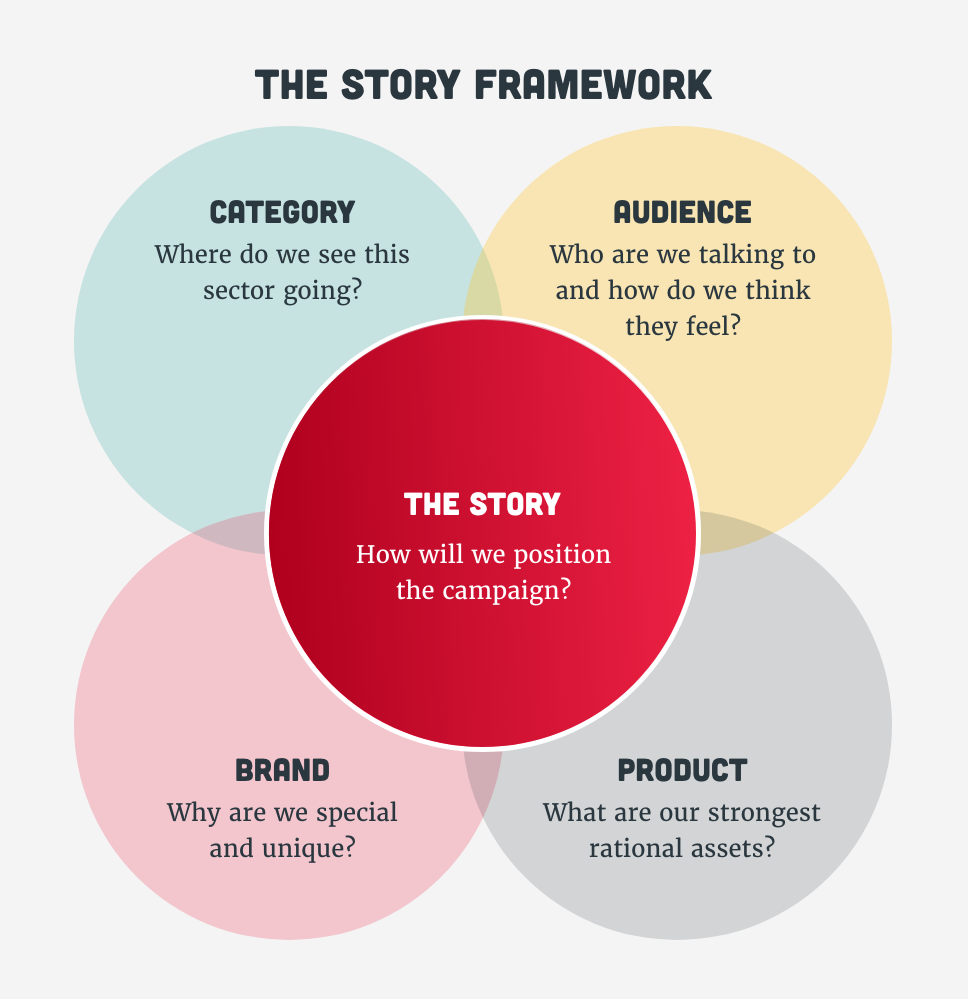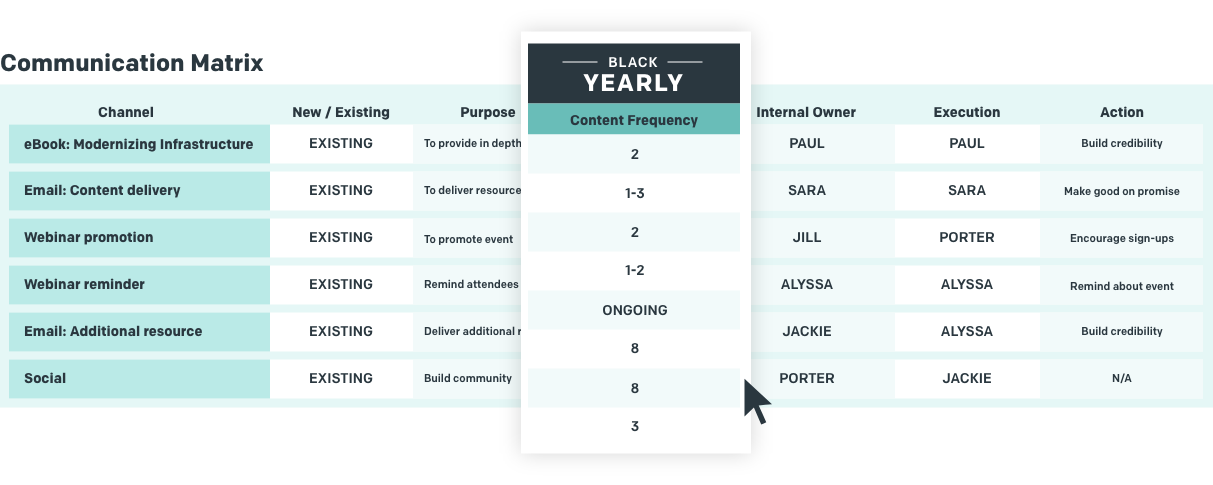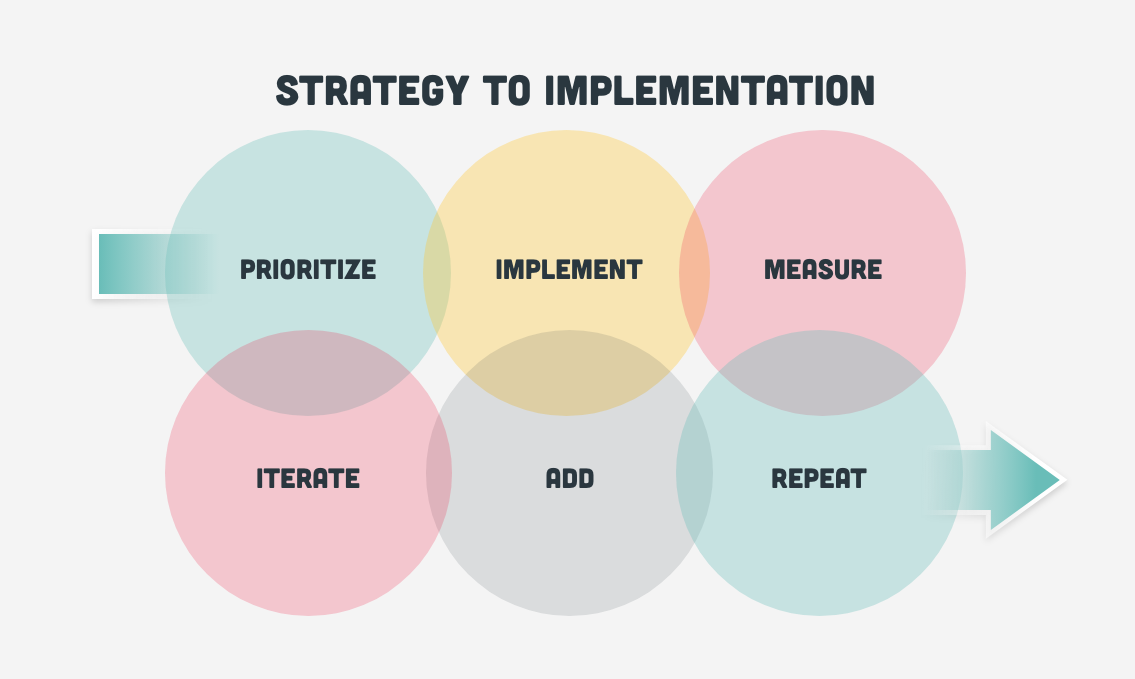A solid marketing strategy is a fundamental element of any successful B2B marketing program, especially in industries as competitive as B2B healthcare, enterprise technology, or health tech. And yet, most of us do not have a written plan. What do we do instead?
There are three common approaches:1. Start a content program that looks like everyone else’s. This likely includes creating a ton of content, doing some SEO work, including some advertising, and hoping that someone falls down to the bottom of your funnel.
2. Another common approach is to choose the en vogue tactics of the moment and make a big investment in them.3. Finally, there is the scattershot approach where you try out one tactic after another without a clear plan for how long you will pilot it, what success looks like, and how you’ll integrate into a cohesive program at the end of the day.
If you’re reading this and it feels familiar, don’t worry, this post was written for you. After reading this, I want you to walk away with all the tools you need to develop a strategy that will allow you to make methodical and strategic decisions despite the fact that we live in one of the most disruptive times in history for B2B marketing.
In this guide, I’ll cover the following topics:
- The Benefits of Developing a Marketing Strategy: We’ll talk through the focus a strategy can provide, how it helps you build momentum and gives you clear insight into when and how to pivot.
- How Strategy Differs from Tactics: Many times we conflate strategy and tactics. I’ll unpack the difference between each and how you can avoid falling into the strategy as tactics trap.
- How to Build a Marketing Strategy That Thrives in Disruption: Our world is changing every day. Our strategies need to flex to this change. I’ll dive into how to make sure strategy doesn’t become stale, but rather, pivots when needed.
- The Importance of Data and Research: No strategy can be built without a strong foundation built in data and research. I’ll explain what work you need to do ahead of time to make sure that your strategy will work effectively.
- How to Structure Your Strategy: I’ll unpack how we structure our marketing strategies at A Brave New so that you can steal it and use it in your own enterprise.
- Identifying the Right Tech Stack to Make Your Strategy Possible: Investing in a tech stack and then building a strategy to match is a classic mistake in marketing. Now, I know you likely have some tech pieces in place, but in this section, I’ll arm you with some tools to determine what has to go, what can stay, and what you need to add to be able to effectively execute and manage your marketing efforts.
Ok! Let’s dive in.
The Benefits of Developing a Marketing Strategy
It may seem self-evident that everyone should have a marketing strategy in place to guide their entire marketing program, but in case some still doubt the reasoning behind this, I thought I would spend a short time talking about what I believe are the 4 main benefits of having a comprehensive plan for your work.
Know where you want to go before you take the first step
The other day I read a statistic that if a pilot takes off from LA en route to Boston and points the plane’s nose just a degree off from the correct flight path, they could end up hundreds of miles off the mark.
The principle is the same here. Your journey to your goals is likely to take many twists and turns, but sitting down to understand WHERE you are trying to go and the philosophy behind HOW you are going to get there will allow you to align your initial efforts in such a way that you’re guaranteed to be heading in the right direction. Now, will that ensure you don’t have to change course down the road? Maybe, maybe not. But that brings me to the next benefit.
Know when and how to pivot
We all know that pivots are inevitable in today’s marketing. In fact, they are not just inevitable, they are a necessity. Just today, I met with my digital media team to talk about the latest iterations and changes we are going to make for the coming month based on the results that we are seeing.
A documented strategy allows you to make these pivots in an intentional way with your end goal in mind. Then, instead of the pivots happening to you, you’re able to evaluate your results and make planned pivots. These consistent pivots in response to real world results lead to the next benefit.
Build momentum
A marketing program focused on providing true value to users is a bit like a freight train: it takes work and a lot of torque to get going. There needs to be constant fuel, and the process is a lot easier if you’re using the fuel that is going to get the engine burning as hot as possible. Just like the train, by being intentional about the go-to-market plan—and by embracing constant pivots—you’ll get up to speed faster.
A beautiful thing happens when you get up to speed. You have momentum, and it’s pushing you forward so that it takes less effort to maintain the same speed—in fact, with minimal effort, you can even accelerate. (Check out this post about the compounding impact of a content program executed over time).
Maintain focus in the midst of disruption
The final benefit may seem straightforward, but I think it bears repeating here. We live in an era of unprecedented disruption. Although the principles of how to build relationships and connection with our audiences stay the same, there is nothing static about the methods we use to reach them, the mediums through which we communicate, and the opportunities we have to think in innovative ways. In the midst of all this disruption, distractions are everywhere.
A documented marketing strategy will keep you from chasing the latest shiny object. Instead, you will be armed with the tools to decide whether each new disruptive opportunity will move your strategy forward or not. This will allow you to adopt new techniques with confidence.
Wait! Is Strategy Really All That Different from Tactics?
Before we go further, I want to address an often asked question: What really is the difference between strategy and tactics? Or, put a different way, I don’t think it really pays to spend a ton of time thinking, it’s action that matters.
These two comments are important to unpack, because there are elements of truth in each. First off, strategy and tactics, although entirely distinct things, are actually complementary. In fact, they depend on each other. A strategy is useless without tactical execution, and tactical execution without strategic thinking won’t drive the results you need. Second, it’s true that it doesn’t pay to spend a ton of time thinking about your strategy if you never get to action. However, you need to do enough thinking.
Still, strategy and tactics are indeed different things. Let’s define both before we go any further:
- Strategy: A comprehensive plan that moves you towards achieving your goals in a decisive and deliberate method.
- Tactics: The specific activities that you do in order to fulfill the plan laid out in the strategy.
Both are vital, but they need to be thought of differently.
How to Build a Marketing Strategy That Thrives in Disruption
I’ve already spent sufficient time in this post establishing the norm of disruption, so I won’t repeat it here. Let’s dive straight into talking about what you need to think about to build a marketing strategy that will not just weather disruption but thrive in the midst of it. I think there are three core principles to consider:
Don’t over-design your strategy
Early in my career, I worked with a non-profit organization to launch a content marketing program. They had never done it before, and to be honest, I probably had too little experience to lead the project. So, I made the mistake that many new strategists make; I planned out every detail to the nth degree.
The results were harrowing. It took us months longer than planned to get to market, and each step was so planned out that when results weren’t as expected, people kept following the plan simply because the plan was too rigid to adjust. Ultimately, my agency lost the account.
This story illustrates a principle that is more important now than it was all those years ago. A strategy must be about overall direction, guidelines, and metrics. It’s about setting the direction and keeping you focused on the things that can’t pivot so that you and your team can be open to changing the rest of the approach easily when something new comes up, whether it be declining results or an entirely new way to reach your audience.
Make sure you know who you are
When I work on branding projects, I tell my clients a simple phrase that is more important today than it has ever been: Your company is only as important as the memory it leaves in its customer’s mind. Great branding identifies that unique memory and helps organizations to engineer it into every part of their being.
With the rapid rate of change and evolution, you’ll be pressed to make decisions, adopt new technologies, or explore new tactics that may or may not be in alignment with the core of your brand. You need to first understand what that core is in order to be able to say no to things that will compromise you and yes to things that align.
Build flexibility into how you manage your strategy
The final essential is flexible governance. You must design your workflow to allow you to pivot quickly. This may mean reevaluating the strategy on a 90-day cycle to make sure it’s still relevant, it may mean committing to adopting a new tactic and establishing a process for deciding which one to take on, or it could entail any other number of things. The main point here is this: build a strategy and governance workflow that plans for evolution. Survival of the fittest, after all, is a real thing.
Getting Started: Building a Foundation with Research and Data
Every great strategy is built on a foundation of research and data. Data provides the quantitative inputs that help you make informed decisions while research adds the color and flavor to your approaches that may not be revealed just by looking at numbers and metrics.
Data analysis
The first thing that you need to do as you embark upon the strategy development process is to look under the hood and evaluate where your program is, where there is opportunity for growth, and where there is already momentum that you can capitalize on. I recommend evaluating your data from three different perspectives.
- The customer flywheel: The first and most important set of metrics to evaluate is the customer flywheel (the HubSpot flywheel is a great example of this). The key idea with this analysis is to take a look at how people are moving through your flywheel from Lead to MQL to SQL to Customer to Evangelist and back again. Where is your conversion rate strong? Where is it weak? Where are people falling off? Answering these questions will identify critical areas of focus for your strategy.
- Brand awareness and loyalty: The next step is to take a look at how well you’re doing at brand awareness. I think two specific approaches can be helpful here. First, if you’ve done the hard work to identify your Total Addressable Market, spend some time analyzing your penetration. This will identify areas where you can continue to push forward. Second, I always recommend doing a deep dive analysis into your website metrics to understand how well you’re capturing and keeping traffic. Your site, after all, is the best place to build affinity to your brand, as long as you can keep people coming back.
- Channel-level metrics: Finally, it’s helpful to analyze how each of your major channels are performing. If you can, compare your performance against relevant industry benchmarks. This will allow you to see which channels are performing well, which are struggling, and which are doing just fine. Remember, building on strong performance is often easier than fixing something that’s broken. The path of least resistance is key.
With a firm understanding of your data under your belt, it’s now time to do some qualitative evaluation of your efforts and the efforts of your biggest competition:
- Content audit: During a content audit, I recommend reviewing all of the content you produced in the previous year. If you produced a ton of content, you may choose a representative sample set. During your review, the goal is to identify which messaging themes, value propositions, content formats, and calls-to-action drove the best results. I’d also conduct a gap analysis to understand if anything is missing so that your new strategy will both build on past success but fill in the gaps. At this point, I also recommend doing a thorough review of your SEO to understand where opportunities lie.
- Competitive analysis: Once you’ve looked at your content, it’s time to look outwards. Evaluate your competitors’ websites and messaging. Use a tool like SEMRush to evaluate their SEO performance. Here your focus is to identify gaps that exist in the market that you can capitalize on.
Research part 2: In-depth interviews
The final bit of research is 30-minute in-depth interviews. These interviews are a valuable tool to utilize for internal stakeholders, current customers, past customers, and prospects. For details about how to conduct a great interview, check out this article.
In my in-depth interviewing, I work to extract the following insights from each group:
- Internal stakeholders: My goal with internal stakeholders is to evaluate the marketing process. I’m hoping to understand what is working well and where roadblocks exist that inhibit efficiency.
- Current customers: When I speak with current customers, my focus is on understanding why they continue to make the choice to work with an organization.
- Prospective customers: In discussions with prospects, I’m trying to understand what makes an organization unique in the marketplace and how they compare to the other companies they are evaluating.
- Past customers: With past customers, I want to learn where the relationship broke down so that I can identify any potential blind spots that we may not have noticed.
Structuring Your Digital Strategy
The moment has arrived, it’s time to build out the strategy. It all starts with a framework.
Every good strategy focuses on telling a single comprehensive story in a consistent way. This framework allows you to build that story intentionally so it can guide all your efforts. Let’s quickly unpack each element:
- Category: Take some time to identify where your industry category is going to ensure that your strategy is future-focused. Ask questions like:
- What will my industry look like in 18 months or 3 years?
- What trends are emerging that will become accepted in the near future?
- What are the most innovative companies in my industry doing?
- How will tech change things?
- Audience: It’s essential to then step into your audience’s shoes so that you have a firm understanding of their needs and wants. Hopefully, you’ve already done the hard work of building out personas. If not, these are the questions we want to answer:
- What keeps my customers up at night with worry?
- What are their turn offs?
- What things do they need to be effective in their everyday work?
- Product (or service): Now take some time to think about your product and really define the unique value proposition it provides. Ask the following:
- What are the strongest elements of our product?
- What do people consistently say are its most important features?
- What does our product or service do that no one else’s does?
- Brand: Write down what makes your brand unique.
The final step in building out this framework is the story at the center of your campaign. The ideal positioning lies at the intersection of category, audience, product, and brand. Spend time thinking through this, throw creative ideas against the wall, let it simmer in the back of your mind. Crafting the right story will be essential to your success.
Objectives, strategies, and metrics
Once you’ve developed the strategy framework, it’s time to build out specific objectives, strategies, and metrics.
- Objectives: With your business goals in hand from senior leadership, it’s time to identify 3-5 objectives that will help you achieve those goals. Keep them high-level. They could be something like: Increase brand awareness by 50% or reduce the time from initial lead conversion to hand off to sales by 30%.
- Strategies: Underneath each objective, list out 4-5 strategies that you will use to reach your objective. If we continue on with the brand awareness example, one strategy you may choose is to cultivate greater social engagement in order to drive more traffic to key brand content.
- Metrics: Finally, for each strategy, identify 1-2 key metrics you will use to evaluate whether you are successful.
The channel map

The final piece of your digital strategy is the channel map. A channel map outlines which channels you will utilize to tactically execute the strategies you’ve identified, the frequency with which you’ll utilize those channels, and how you’ll measure success in each of them.
I find it especially helpful when building a channel strategy to identify the priority of each channel. This really allows me to focus my efforts.
A note about measurement frameworks and growth-driven design
A deep dive into frameworks for measuring results could be the subject of an entire post. So here, the only thing I will say is that we are big fans of using a growth-driven design approach. Here’s why: it encourages you to look at only the most important metrics and pushes you down the road of constant improvement and iteration.
Enabling Your Strategy with the Right Tech
Once you have a strategy in place, it’s time to evaluate whether your tech can support the strategy. Let’s take a quick look at how to do that before we wrap things up.
Technology checklist
If you aren’t sure what tech you need in place, here is a simple checklist of the core pieces that you need to have in place to be successful:
- Marketing automation platform
- Social media management tool
- Advertising platform(s)
- Content management system
- Reporting suite
Keep, discard, upgrade
With this list in mind, I encourage you to evaluate which technology you want to keep because it does what you need it to do, which technology should be discarded because it is extraneous, and which platforms need to be upgraded with more robust tools.
This process is essential because having the wrong tech in place can ruin a strategy, no matter how brilliant. Keeping this in mind, it’s also incredibly important to make sure all other options have been explored before migrating to a new tech platform. Migrations are simply too difficult and complex to be taken lightly.
Moving from Strategy to Implementation
Now that we’ve covered the core aspects of building out a marketing strategy, it’s time to talk through how to move into implementation. I find it helpful to follow this simple 6-step framework:
- Prioritize: It’s likely that the strategy you’ve designed is ambitious, so you’ll need to prioritize what to implement first. I like to prioritize my tactics into 3 tiers. This allows me to work sequentially without being overwhelmed.
- Implement: Once you’ve decided what is the most important, it’s time to do the hard work of implementation. We all generally know what to do here, but I have one learning that I hope you’ll take to heart: make sure that, whenever necessary, you take the extra steps to make your efforts easily repeatable rather than one-offs, otherwise things will become unsustainable fast.
- Measure: At regular intervals (I talked about quarterly early in the post), take a deep dive into your results and identify what is working well, what can be improved, and what must be stopped altogether. This will guide your efforts in the next step.
- Iterate: Guided by the findings of your results review, iterate on your approach. Over the course of 3, 6, or 9 months, your marketing tactics should look different than when you started (while still remaining faithful to your strategy!).
- Add: At the end of the cycle, it’s time to add in an additional tactic, whether it’s from the same priority tier or from the next tier down.
- Repeat: Marketing is a cycle, not a linear journey. So, when you’ve made it down to step 5, you should know what’s coming. It’s time to dive right back in, reprioritize, and restart your implementation cycle.
And there you have it! In this post, I hope I’ve given you all the tools to develop an effective marketing strategy—and put it into action. If you found this post helpful, I hope you’ll subscribe to receive new posts in your inbox whenever we publish. Our mission is to help B2B healthcare and tech companies build brands that will be remembered, and you can be sure we’ll fulfill that mission with each additional installment. You can sign up here.
Don’t miss out, get Brave News now
Join the ABN community and be the first to learn about trends in inbound marketing, branding, and web design.







